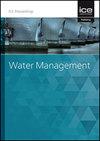溃坝与溃坝建模的配置离散子域无网格方法
IF 0.9
4区 工程技术
Q3 ENGINEERING, CIVIL
Proceedings of the Institution of Civil Engineers-Water Management
Pub Date : 2019-03-14
DOI:10.1680/JWAMA.16.00101
引用次数: 2
摘要
本文介绍了一种“配置离散子域无网格法”,用于求解具有泥沙质量守恒的自由水面浅水方程。该方法采用分布式节点对计算域进行离散。形状函数采用移动最小二乘法求解,既高效又简单。使用若干独立于节点点的并置点构成指定残差函数。在问题域和边界上,每个子域的并置点残差之和为零。此外,边界条件很容易执行。通过对溃坝水流的模拟和物理模拟结果的比较,验证了模型的正确性。解析解与实验实测数据吻合较好,具有较高的收敛速度和效率。该方法对于研究水流与泥沙耦合输运的各种问题似乎具有重要的潜力。本文章由计算机程序翻译,如有差异,请以英文原文为准。
Collocated discrete subdomain meshless method for dam-break and dam-breaching modelling
This paper introduces a ‘collocated discrete subdomain meshless method’ to solve shallow water equations for free-surface flows with conservation of sediment mass. The computational domain in the method is discretised by distributed nodal points. Shape functions are made using the moving least-squares method for efficiency and simplicity. A number of collocation points, independent of nodal points, are used to form the specified residual function. The sum of residuals at the collocation points for each subdomain is zero in the problem domain and boundaries. In addition, boundary conditions are readily enforced. The model was verified by comparing results of simulated and physically modelled dam-break flows. There was good agreement between the analytical solution and experimental measured data, and a high convergence rate and efficiency were achieved. The method appears to have significant potential for investigating a variety of problems concerning coupled flow with sediment transport.
求助全文
通过发布文献求助,成功后即可免费获取论文全文。
去求助
来源期刊
CiteScore
2.10
自引率
0.00%
发文量
28
审稿时长
6-12 weeks
期刊介绍:
Water Management publishes papers on all aspects of water treatment, water supply, river, wetland and catchment management, inland waterways and urban regeneration.
Topics covered: applied fluid dynamics and water (including supply, treatment and sewerage) and river engineering; together with the increasingly important fields of wetland and catchment management, groundwater and contaminated land, waterfront development and urban regeneration. The scope also covers hydroinformatics tools, risk and uncertainty methods, as well as environmental, social and economic issues relating to sustainable development.

 求助内容:
求助内容: 应助结果提醒方式:
应助结果提醒方式:


